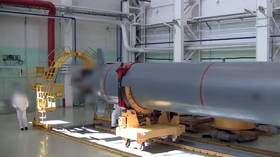Russia’s Poseidon underwater drone can hit at least 200km/h – reports

Poseidon, Russia’s brand new underwater drone, will be able to travel at a whopping speed of up to 200km/h (125mph) and dive as deep as 1km to pierce any defenses, reports say.
The unmanned underwater vehicle (UUV) “could penetrate any submarine warfare countermeasures and other enemy defense systems due to a fully autonomous control system,” a source within the military revealed to the TASS news agency.
It also shed some more light on the secretive weapon, many features of which are classified.
Also on rt.com 'Doomsday weapon’: How could the West respond to Russia’s nuclear underwater drone?Poseidon will be able to dive at over 1km (0.6 miles) and at such depth the engine can propel her to 200km/h, the source added. “Taken altogether, intellectual and propulsion capabilities will make the vehicle invincible and make sure that it hits the target.”
The secretive torpedo is to be carried by a nuclear-propelled submarine of the Russian Navy.
While Poseidon’s velocity and maximum diving depth may seem surprising to the public, the technologies developed in the Soviet times may give clues as to how it became possible.
For instance, the Russian nuclear-powered submarine K-278 Komsomolets once reached a record submergence depth of 1,027 meters in the Norwegian Sea, Mikhail Khodarenok, a Russian military expert told RT.
“At 800 meters she was able to fire mock torpedoes through its tubes,” the expert said.
Likewise, there was an ultra-fast torpedo that entered service with Soviet Navy back in 1977. Dubbed ‘Shkval’ (Squall), the anti-ship weapon could travel at 200 knots or 370km/h under water due to its solid-fuel rocket engines.
“If much of this has been done long time ago, then why can’t these features be reproduced today, especially given the fact that all technologies, design bureaus, developers and traditions have been preserved?” the expert asked.
It is very likely that Poseidon can dive much deeper and move much faster than publicly acknowledged, he suggested. Everything available in the open sources “is to conceal true performance features” of the UUV, the expert argued. He said this is “common practice.”
Like this story? Share it with a friend!















